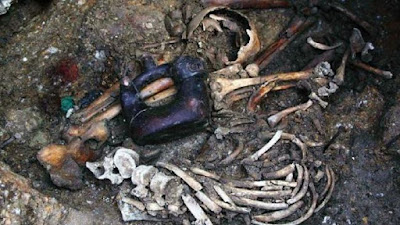AN intact 2700-year-old tomb has been unearthed in Peru, containing the mysterious remains of two ‘Serpent Jaguar’ priests and their symbols of power.
The priests have been given the ‘Serpent-Jaguar’ name because of a distinctive ceramic vessel found among their bones: A finely crated handheld jug in the shape of a serpent with a jaguar’s fierce head.
The pre-Incan Chavin culture ceremonial site at San Pedro de Pacopampa, Cajamarca is believed to have been occupied between 1200 and 500BC. It sits some 2100m high in the Andes mountains.
Pacopampa has been the site of extensive archaeological excavations in recent years, including several unusual burial pits.
But the most recent discovery, by a team of Japanese and Peruvian researchers earlier this month, is among the most significant finds yet.
Funerary goods ... The serpent-jaguar jug, left, and the coiled beads of the necklace found with a second priest. Source: Pacopampa / Cultural de la NacionSource:Supplied
Both bodies were buried in the foetal position, with one facing south and the other north.
The black jug had been buried with one body, while 25 gold beads of stylistic coiling snakes shaped in figure-eights formed a neck ornament worn by the second priest.
Both were buried with piles of bright red, dark brown, deep black, bright green and bright white mineral pigments. The significance of these minerals and colours is not yet understood.
They had been interred on the edge of a large elevated communal square surrounded by walls of engraved stones. Two stone staircases lead to the platform.
“This courtyard was the scene of public meetings where ceremonial activities involving the consumption of food and drink were made. Perhaps these individuals participated in these feasts, “ Professor Yuji Seki told the La Republica news service.
The Pacopampa ceremonial site high in the Andes mountains. Source: Pacopampa / Cultural de la NacionSource:Supplied
“Finding these remains in the same place where rituals and feasts were held, we assume they could have been priests in charge of ceremonies during this culture’s peak, between 800 and 500BC,” project co-director Daniel Morales said.
The gender of the priests is yet to be determined and represents the next stage of the excavation. Archaeologists say more bodies may lay beneath them.
Until the find researchers had believed the Chavin culture did not have a noble or priestly elite.
The serpent-jaguar motif, however, was a recurring motif among religious relics of the era, the researchers said.

No comments:
Post a Comment